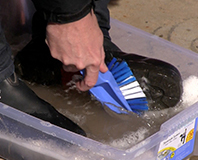Read the latest information on
Foot-and-mouth disease
 Agricultural tourism and working holidays are a big part of many farm operations, though naturally these activities pose a big risk of introducing or spreading diseases, pests and weeds.
Agricultural tourism and working holidays are a big part of many farm operations, though naturally these activities pose a big risk of introducing or spreading diseases, pests and weeds.
In the wake of a number of large agricultural events, many of which have featured displays, open days and property tours, Animal Health Australia and Plant Health Australia are reminding producers hosting overseas or interstate workers, tours and field days to manage those risks appropriately.
Tourism is really important in agriculture, as it allows those not involved in animal rearing and food production to get a glimpse of life on the land, according to Dr Simon Humphrys, Executive Manager Biosecurity and Product Integrity at Animal Health Australia.
“The downside is the increased movement of people and vehicles around the country, many of whom will visit a number of properties in a single trip or over successive days and weeks. This prompts an obvious need for thorough biosecurity measures,” said Dr Humphrys.
“People can carry diseases, pests and weed seeds without realising. Always ensure visitors are taking appropriate hygiene measures when coming into contact with plants, livestock, or entering at-risk production zones. These measures can include a hand sanitizing station, footbaths, or better yet provide boots for use on the property.”
Some properties, such as vineyards and those offering fruit picking experiences, are at a higher risk of biosecurity incursions from vehicles and equipment. This can be addressed through a zoning system, according to Plant Health Australia’s Program Manager, Farm Biosecurity Programs, Mr Stuart Kearns.
“Clear separation between public zones and production zones limits the number of pathways for a disease agent, pest or weed to enter. This includes adequate fencing, directional signage and dedicated parking for visitors,” Mr Kearns said.
“Having equipment and vehicles which are explicitly for use in production zones also prevents cross-contamination between zones and especially to or from other properties.”
Other methods of managing visitors includes risk assessments and log books, allowing you to understand where your guests have come from, where they are going next, and what risks they might pose. However, these methods may not be practical when dealing with large groups of people. In this case, visitors are best managed by articulating your entry requirements and ensuring visitors take part in the complete biosecurity regime before coming into contact with plants, livestock and production zones.
For more information on managing biosecurity risks for visitors to your property, visit the People, Vehicles & Equipment page on the Farm Biosecurity Website.